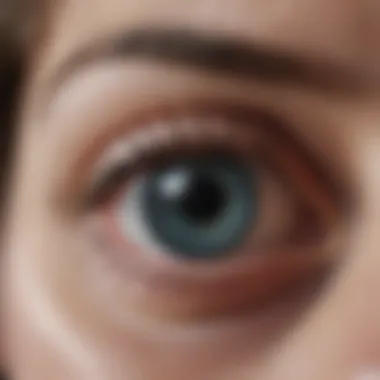Understanding the Causes of Optic Nerve Swelling


Intro
Optic nerve swelling, commonly referred to as papilledema, is a significant medical condition. It acts as a visual symptom, alerting clinicians to possible underlying issues related to the optic nerve or adjacent structures. Understanding this condition is crucial for early diagnosis and effective treatment. The swelling often results from increased pressure within the cranial cavity, inflammatory processes, or infections. This article provides insights into the causes, diagnostic methods, and treatment options for optic nerve swelling.
Research Overview
Summary of key findings
Recent studies indicate that papilledema can arise from various conditions such as increased intracranial pressure due to brain tumors, head trauma, or hydrocephalus. Inflammatory conditions like multiple sclerosis also contribute to this issue. Infectious diseases, such as meningitis, can lead to optic nerve swelling as well. Each cause has distinct mechanisms that warrant detailed examination. Recognizing these factors helps in forming a comprehensive clinical picture.
Importance of the research in its respective field
Methodology
Description of the analytical methods used
The investigation into the causes of optic nerve swelling employs both qualitative and quantitative approaches. Case studies, imaging techniques such as MRI and CT scans, and laboratory tests play substantial roles in diagnosis. Clinicians often use visual field tests to assess the degree of optic nerve involvement. These methods allow for a multifaceted understanding of each case.
Sampling criteria and data collection techniques
In studies, a diverse range of patients is considered. Sampling includes individuals with various risk factors or existing conditions linked to optic nerve swelling. Data collection occurs through patient histories, clinical examinations, and follow-up over time. These comprehensive methodologies ensure reliability and validity in findings.
"Understanding optic nerve swelling is not only about identifying the symptom but also about uncovering the underlying causes and their implications."
Research on this complex condition can lead clinicians and researchers to develop tailored treatment plans. It can also offer patients a clearer understanding of their medical situations, paving the way for improved visual health.
Overview of Optic Nerve Function
Optic nerve function is a critical aspect in understanding the overall health of the visual system. The optic nerve transfers visual information from the retina to the brain. This section acts as a foundational overview, providing insight into the anatomy and role of the optic nerve in vision, which is essential for comprehending the implications of optic nerve swelling.
Anatomy of the Optic Nerve
The optic nerve consists of approximately 1.2 million nerve fibers. These fibers originate from ganglion cells located in the retina. The nerve's structure includes several layers, including the axons of retinal ganglion cells, myelin sheaths, and supportive glial cells. The overall length of the optic nerve is about 25 millimeters, and it travels from the back of the eye to the brain through the optic canal.
In terms of blood supply, the optic nerve depends on the central retinal artery as well as other smaller vessels. Any obstruction or disruption in this blood supply can lead to optic nerve complications, including swelling. Understanding the anatomy is crucial because changes in this structure can indicate various pathologies.
Role in Vision
The primary role of the optic nerve is to convey visual stimuli from the retina to the lateral geniculate nucleus in the thalamus, and subsequently to the visual cortex in the brain. This process is essential for sight. The interpretation of these signals allows for image clarity, perception of color, and recognition of motion.
When optic nerve swelling occurs, this pathway can become disrupted. Patients may experience symptoms such as blurred vision or partial vision loss. This can signal significant underlying health issues that require immediate attention. Understanding the nerve's role in vision also highlights the potential consequences of its swelling on a person's overall quality of life.
"The optic nerve is not merely a data cable; it is the vital link between sight and perception."
By appreciating the complex structure and function of the optic nerve, we set the stage for a deeper exploration of the various causes of swelling in this crucial pathway.
Defining Optic Nerve Swelling
Defining optic nerve swelling is essential for understanding its implications for visual health. This section clarifies what optic nerve swelling, or papilledema, involves and why it matters to both medical professionals and patients.
The optic nerve plays a crucial role in transmitting visual information from the retina to the brain. When it swells, it indicates potential complications. Proper definition and understanding allow for better communication among healthcare providers and clearer expectations for patients discussing their symptoms or conditions.
What is Papilledema?
Papilledema is a specific type of optic nerve swelling caused by increased intracranial pressure. Such pressure can arise from a range of conditions. These may include tumors, hydrocephalus, or severe hypertension. The optic nerve head becomes elevated when fluid accumulates.
The condition is often asymptomatic in its early stages, making awareness critical. If unnoticed, it can lead to vision loss or other serious complications. Diagnosing papilledema often involves fundoscopic examination where the healthcare provider can visualize the swelling. The degree of elevation can give insights into the severity and potential causes of increased intracranial pressure.
Symptoms of Optic Nerve Swelling


Symptoms of optic nerve swelling can be subtle or overt. Some individuals may experience headaches, which are often a result of the underlying conditions causing the swelling. Vision changes, including blurriness or transient visual obscurations, also characterize this condition. In rare cases, individuals might report double vision or changes in color perception.
Here are some common symptoms associated with optic nerve swelling:
- Headaches: Often described as persistent and can be indicative of increased pressure.
- Visual disturbances: This can range from blurriness to blind spots in peripheral vision.
- Nausea and vomiting: Sudden increases in intracranial pressure can lead to these symptoms.
- Transient visual obscurations: Episodes of temporary vision loss, often triggered by changes in position.
Understanding these symptoms is vital for early detection and intervention, which can mitigate long-term vision loss.
Causes of Optic Nerve Swelling
Increased Intracranial Pressure
Increased intracranial pressure is one of the most common causes of optic nerve swelling. This condition can result from a variety of factors including traumatic brain injury, hydrocephalus, and brain tumors. The increased pressure within the cranial cavity exerts stress on the optic nerve, leading to edema at its head.
When left unchecked, increased intracranial pressure can lead to severe complications. Patients may experience headaches and altered consciousness, alongside visual changes. Monitoring intracranial pressure is vital in managing these patients. Healthcare professionals often employ tools like lumbar punctures and imaging studies to assess this condition.
Inflammatory Conditions
Inflammatory conditions are another significant cause of optic nerve swelling. Disorders such as optic neuritis and multiple sclerosis can lead to inflammation of the optic nerve. In these scenarios, the body's immune response mistakenly targets the nerve, causing swelling and affecting vision.
Aside from vision impairment, symptoms may also include pain with eye movement and color vision changes. Early detection and treatment of these inflammatory conditions are crucial to prevent long-term vision loss. Corticosteroids are commonly used in such cases to reduce inflammation.
Vascular Disorders
Vascular disorders contribute to optic nerve swelling by disrupting blood flow. Conditions such as central retinal vein occlusion can lead to ischemia and subsequent edema of the optic nerve. In these cases, the blood supply to the nerve is compromised, leading to swelling and ischemic damage.
Management of vascular disorders often involves addressing the risk factors like hypertension and diabetes. Identifying these underlying conditions is essential in mitigating the chances of vision loss associated with vascular complications.
Infectious Diseases
Infectious diseases can also cause optic nerve swelling. Conditions such as meningitis and syphilis lead to inflammation due to infections affecting surrounding tissues. This inflammation can result in papilledema as the optic nerve becomes involved in the systemic response.
Recognizing infectious causes requires accurate history-taking and sometimes specific tests to identify pathogens. Treatment typically involves antibiotic or antiviral therapy, depending on the organism involved.
Tumors and Mass Effects
Lastly, tumors and mass effects represent a critical source of optic nerve swelling. Tumors, whether malignant or benign, can create pressure on the optic nerves or surrounding structures, leading to swelling. This group includes primary brain tumors as well as metastatic diseases.
Healthcare providers must consider a range of imaging studies to identify these mass effects. Surgery, radiation, or oncological treatments may be necessary depending on the tumor's nature and location. Early intervention is key to preserving vision in these cases.
Mechanisms of Swelling
Understanding the mechanisms of swelling in the optic nerve is a crucial aspect of fully grasping the implications of this condition. Optic nerve swelling is often a sign that points to underlying issues that may affect visual health. By exploring the specific elements and processes involved in swelling, we gain a better insight into its causes and potential ramifications. The relevance of this section lies in its ability to bridge the gap between basic scientific principles and clinical practice, providing essential knowledge for diagnosis and treatment.
Pathophysiology of Papilledema
The term "papilledema" refers to the swelling of the optic disc due to the accumulation of fluid caused by increased intracranial pressure. It is important to note how this related pathophysiology works. The increased pressure around the brain can hinder the proper drainage of cerebrospinal fluid, causing it to flow backward towards the optic nerve. This backward flow can stretch or compress the nerve, leading to swelling. In some cases, the underlying cause may include conditions like tumors, meningitis, or severe hypertension.
Some common indicators of papilledema include:
- Blurred vision or visual disturbances
- Headaches
- Nausea and vomiting
Understanding this pathophysiology helps physicians determine the urgency of treatment and possible interventions. When faced with papilledema, timely diagnosis and action can prevent permanent damage to the optic nerve and subsequent loss of vision.
Role of Cerebrospinal Fluid
Cerebrospinal fluid (CSF) plays a vital role in the health of the central nervous system, acting as a protective cushion that surrounds the brain and spinal cord. In the context of optic nerve swelling, the dynamics of CSF become particularly significant. The pressure within the CSF can influence how the optic nerve performs its functions. When there is excess pressure due to an imbalance of CSF production and absorption, this may lead to dangerous conditions like papilledema.
Key aspects of CSF's role include:


- Regulation of intracranial pressure: Maintaining appropriate levels of CSF is critical to prevent pressure build-up.
- Nutritional support: CSF provides nutrients and removes waste products from the brain and spinal cord.
Monitoring CSF levels and understanding its pathophysiology enables healthcare professionals to effectively manage conditions associated with optic nerve swelling. Moreover, knowledge of the CSF's role can also assist in developing treatment strategies to restore balance and alleviate pressure on the optic nerve.
Diagnosis of Optic Nerve Swelling
Diagnosing optic nerve swelling is a critical step in understanding the underlying causes of this condition. Early and accurate diagnosis can prevent progression and potentially preserve vision. Without a thorough examination and appropriate tests, one might overlook serious conditions leading to swelling. Thus, a comprehensive approach is required to evaluate this health issue.
Clinical Examination Techniques
Clinical examination is the initial step in diagnosis. An ophthalmologist typically performs a detailed examination of the optic nerve through techniques such as:
- Visual Acuity Tests: These tests measure how well the eyes can see at various distances, helping to determine the extent of any vision loss.
- Fundoscopy: This involves using an opthalmoscope to closely inspect the optic disc. Characteristics like the disc's color, shape, and the presence of swelling are crucial.
- Visual Field Testing: This assesses peripheral vision and helps identify any blind spots that may result from optic nerve issues.
These techniques are usually effective in indicating whether swelling is present. Moreover, they provide significant information related to the health of the optic nerve.
Imaging Studies
Imaging studies play an essential role in diagnosis. Techniques like Magnetic Resonance Imaging (MRI) and Computed Tomography (CT) scans offer valuable insights into the structures surrounding the optic nerve. Some key points about imaging studies are:
- MRI: It is particularly useful in identifying masses, lesions, and other anomalies. Any significant findings can assist in determining the cause of swelling.
- CT Scans: These are often used to rule out any acute issues like hemorrhages or fractures that could contribute to swelling.
Imaging results can be pivotal in forming a diagnosis, enabling healthcare professionals to formulate an appropriate treatment plan.
Lumbar Puncture Considerations
A lumbar puncture, or spinal tap, can also be a significant diagnostic tool. This procedure involves collecting cerebrospinal fluid (CSF) for analysis. Here are important considerations:
- Indications for Procedure: It is often recommended when increased intracranial pressure is suspected or when infection or inflammatory disease needs to be ruled out.
- CSF Analysis: The fluid's composition can reveal inflammatory cells, cancer cells, or infections like meningitis.
- Risks and Benefits: While generally safe, a lumbar puncture does carry some risks. Thus, a careful risk-benefit assessment is necessary before proceeding.
Conducting a lumbar puncture can provide crucial information about the state of the central nervous system and help identify conditions leading to optic nerve swelling.
Treatment Options
Effective management of optic nerve swelling, or papilledema, is crucial for preserving visual function and addressing underlying health issues. Treatment strategies delve into easing the symptoms and tackling the root causes, which can vary significantly from patient to patient. Understanding the broad spectrum of treatment options allows healthcare professionals to personalize therapies, ensuring optimal outcomes for individuals afflicted by this condition.
Managing Underlying Conditions
One of the primary steps in treating optic nerve swelling involves identifying and managing the underlying conditions that contribute to increased intracranial pressure. Common causes can include, but are not limited to, hypertension, intracranial tumors, and infections. For instance, if patient has hypertension, then managing blood pressure is critical. In case of tumors, appropriate oncological evaluation and intervention are necessary. In some other instances, lumbar puncture can be performed to reduce pressure temporarily while further evaluations take place. Hence, it is essential to collaboratively work with a multidisciplinary team, incorporating neurology, ophthalmology, and primary care specialists to effectively address these contributing factors.
Medications
Medications play an important role in treating optic nerve swelling. Corticosteroids are commonly prescribed to reduce inflammation, especially when swelling results from autoimmune conditions or inflammatory diseases. Another class of medication involves diuretics, such as acetazolamide, which may help decrease cerebrospinal fluid production. This reduction in fluid can alleviate pressure on the optic nerve. In some cases, antibiotics or antivirals may be indicated when infections are at play. Discussing medication options clearly with patients is vital, as it ensures they understand potential side effects and the importance of adherence to prescribed regimens.
Surgical Interventions
In certain situations, surgical intervention becomes necessary. For patients with severe optic nerve swelling due to mass effects from tumors or other structural abnormalities, surgical procedures may relieve pressure on the optic nerve. This can include resecting tumors or implementing shunts to reduce cerebrospinal fluid accumulation. Surgical options are often considered carefully, with thorough discussions about the risks and benefits involved. Ensuring that patients know what to expect during and after the procedure can make a substantial difference in their recovery process.
"Timely intervention can significantly help in preserving visual acuity in patients with optic nerve swelling."
In summary, the treatment options for optic nerve swelling encompass a range of strategies aimed at addressing both the symptoms and underlying causes. A comprehensive approach that includes managing underlying conditions, utilizing medications, and considering surgical options ensures that the diverse needs of patients are met effectively.
Prognosis and Outcomes
Understanding the prognosis and outcomes of optic nerve swelling is essential for managing the condition effectively. Patients facing such swelling must be aware of the potential long-term implications and the importance of early intervention. The prognosis can vary significantly based on the root cause, the promptness of diagnosis, and the commencement of treatment. Healthcare providers often emphasize the need for comprehensive assessments to tailor appropriate treatment strategies that could affect long-term vision and overall health.
Long-Term Effects of Swelling
Optic nerve swelling can lead to various long-term effects, particularly if the underlying causes remain untreated. Chronic swelling can result in permanent damage to the optic nerve fibers. This situation may manifest as a gradual loss of vision, often referred to as "visual field defects." In some cases, patients may experience a condition known as "non-arteritic ischemic optic neuropathy" which can further complicate presentation. Moreover, unresolved swelling may increase the risk of further complications, such as retinal atrophy, which ultimately impairs visual function.


Key Effects to Consider:
- Vision Loss: Persistent swelling may deteriorate vision over time.
- Quality of Life: Challenges in daily activities due to visual disturbances.
- Psychosocial Impact: Potential anxiety and social withdrawal stemming from vision issues.
It is crucial that patients remain under regular observation so that any changes in their condition can be addressed swiftly. Early detection of new symptoms can potentially mitigate long-term consequences.
Impact on Vision
The direct repercussions of optic nerve swelling on vision are profound. Patients may face blurred vision, double vision, or even severe visual impairment. These conditions arise primarily from increased pressure within the optic nerve, which disrupts the normal signaling pathways between the eye and the brain. Impaired vision can vary from mild disturbances to complete vision loss, depending on the severity and duration of the swelling.
The nature of the impact on vision is often contingent on the specific etiological factors at play. For instance, if the swelling is a result of increased intracranial pressure due to a tumor, vision may be affected quite differently than if the swelling is linked to an inflammatory process like optic neuritis.
To summarize, optic nerve swelling can lead to significant visual impairments, emphasizing the importance of prompt diagnosis and effective treatment strategies. Continuous monitoring and timely intervention are vital for improving patient outcomes and preserving vision effectively.
Preventive Measures
Preventive measures play a crucial role in maintaining optic nerve health and averting the onset of optic nerve swelling, often associated with serious underlying conditions. Addressing factors that contribute to swelling can significantly enhance overall visual health. This section will explore key preventive strategies, their benefits, and considerations for implementation.
Lifestyle Modifications
Adopting healthy lifestyle changes can help mitigate the risk of optic nerve swelling. Here are some effective modifications:
- Maintain a Healthy Diet: Nutrition is vital for optic nerve health. Diets rich in antioxidants, vitamins A, C, and E, and omega-3 fatty acids can potentially protect nerve fibers from damage. Foods such as carrots, leafy greens, fish, and nuts are exemplary choices.
- Stay Hydrated: Adequate hydration supports overall bodily functions and can help maintain optimal intracranial pressure. Aim for at least eight 8-ounce glasses of water daily.
- Exercise Regularly: Physical activity improves blood circulation, reduces stress, and helps maintain a healthy weight, which in turn influences intracranial pressure positively. Activities like brisk walking, swimming, or cycling are beneficial.
- Limit Alcohol and Caffeine Intake: Excessive consumption of alcohol and caffeine can lead to dehydration and affect blood flow to the optic nerve. Reducing intake can have long-term positive effects on visual health.
- Manage Stress: High stress levels can exacerbate underlying health conditions. Techniques such as yoga, meditation, and mindfulness can be effective in reducing stress.
Implementing these lifestyle changes does not require drastic measures. Gradual adjustments can often result in sustained improvements in health and well-being.
Regular Eye Examinations
Regular eye examinations are an essential aspect of preventive care for optic nerve health. These exams are crucial for early detection of potential issues that may lead to optic nerve swelling. Here are some key points regarding the importance of eye examinations:
- Early Detection of Problems: Routine exams help in identifying vision changes or risk factors early. If swelling begins, timely intervention can prevent further complications.
- Assessment of Eye Pressure: Eye examinations often include measuring intraocular pressure. Elevated pressure can indicate conditions like glaucoma, which is linked to optic nerve damage.
- Comprehensive Evaluation: An eye examination provides an opportunity for comprehensive assessments that can reveal other health issues, such as hypertension or diabetes, which may contribute to optic nerve swelling.
- Awareness and Education: Regular visits to an eye care professional serve to keep patients informed about maintaining eye health and understanding warning signs of complications.
It is recommended to have an eye examination at least once every two years, or more frequently if you have risk factors or family history of eye diseases. While eye exams may seem minor, they hold significant value in protecting against severe conditions, including optic nerve swelling.
"Preventive measures are often the first line of defense against conditions that threaten visual health. Early action can save sight."
Understanding and integrating preventive measures into daily routines can lead to better outcomes regarding optic nerve health. It empowers individuals to take charge of their vision and overall health.
Research Trends and Future Directions
The field of optic nerve disorders is evolving rapidly, with ongoing research dedicated to uncovering the complexities of optic nerve swelling and its causes. Understanding these trends is crucial for advancing diagnosis, treatment, and patient outcomes. Continuous investigation into the pathophysiology underlying optic nerve swelling holds the promise of tailoring therapies to individual patient needs and improving overall visual health.
Current Research in Optic Nerve Disorders
Recent studies focus on several key areas regarding optic nerve disorders. Research into biomarkers for early detection is gaining traction. Biomarkers can help identify patients at risk for conditions associated with optic nerve swelling. For instance, investigations are being conducted into the role of specific inflammatory markers that could indicate optic nerve dysfunction at an early stage.
Additionally, there is significant emphasis on genetic studies that explore hereditary factors contributing to optic nerve swelling. Understanding the genetics may lead to breakthroughs in preventive strategies and personalized treatments.
Moreover, advances in imaging technology are transforming how optic nerve conditions are diagnosed and monitored. Techniques such as optical coherence tomography (OCT) provide high-resolution imaging of the optic nerve and can facilitate more accurate assessments of swelling.
- The integration of machine learning in data analysis also offers exciting prospects. Algorithms can help discern patterns in patient data that may indicate a higher risk of developing optic nerve disorders.
- Research into chronic conditions affecting the optic nerve, such as hypertension and diabetes, is expanding. Understanding interactions between these conditions and optic nerve swelling can provide clearer insights into management.
Emerging Therapies
Innovations in therapeutic approaches can effectively mitigate optic nerve swelling and enhance patient outcomes. Numerous experimental therapies are currently under investigation, including:
- Monoclonal Antibodies: These agents target specific pathways involved in inflammation and may help reduce optic nerve swelling in conditions like multiple sclerosis.
- Neuroprotective Agents: Compounds designed to protect nerve cells from damage are being studied for their efficacy in preserving optic nerve function.
- Intravitreal Injections: Administering medication directly into the eye has shown potential in treating localized inflammation that contributes to optic nerve swelling.
Furthermore, gene therapy presents a novel approach. By directly modifying or correcting genetic defects associated with optic nerve disorders, this strategy could revolutionize treatment options.
As research continues to advance, it is vital for professionals and patients alike to stay informed about these developments. New findings will likely shape clinical practices and offer hope for those affected by optic nerve swelling.
"Continuous research in optic nerve disorders not only enhances our understanding but also paves the way for innovative therapeutic strategies that can improve the quality of life for patients."
Collectively, these trends reflect a commitment within the medical community to address optic nerve swelling comprehensively. By furthering research initiatives, the likelihood of unraveling the complexities of optic nerve diseases increases. This can potentially lead to better management and treatment strategies that meet the diverse needs of patients.







